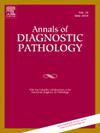Comparative analysis of MIB1 and SP6 antibodies for Ki-67 assessment in breast carcinoma with focus on the influence of molecular subtyping
IF 1.4
4区 医学
Q3 PATHOLOGY
引用次数: 0
Abstract
Ki-67 is a nuclear protein used as a proliferation marker in breast carcinoma, aiding in tumor classification and prognostic assessment. However, its clinical utility is limited by variability in immunohistochemical assessment, influenced by numerous factors, including differences in antibody clones. This study aims to compare the performance of two widely used Ki-67 antibody clones, MIB1 and SP6, and to evaluate their impact on molecular subtyping in breast cancer. Sections from formalin-fixed, paraffin-embedded biopsy samples from 35 primary breast carcinoma cases were stained using MIB1 and SP6 antibodies. Histological tumor characteristics and receptor statuses were evaluated for each case. The Ki-67 proliferative index was assessed following the latest recommendations of the International Ki-67 in Breast Cancer Working Group. Statistical analysis included Pearson correlation, paired t-test, Welch's ANOVA, and McNemar's test. A strong correlation was observed between Ki-67 indices obtained using MIB1 and SP6 (r = 0.755, p < 0.001), with no statistically significant difference in mean values (p = 0.288). Ki-67 index correlated significantly with tumor grade for both antibodies. Among Luminal HER2-negative tumors, 17 % showed discordant molecular subtyping between MIB1 and SP6 using a 20 % cut-off. Similar discrepancies were observed at 14 % and 25 % cut-offs, suggesting that antibody choice may affect subtype classification. In conclusion, both MIB1 and SP6 provide reliable assessment of proliferative index in breast carcinoma, however, discrepancies in individual cases may impact molecular subtyping and subsequent clinical decision-making. Therefore, reporting the antibody clone used in Ki-67 evaluation may be advisable, pending further validation.
MIB1和SP6抗体在乳腺癌Ki-67检测中的比较分析及分子分型的影响
Ki-67是一种核蛋白,在乳腺癌中被用作增殖标志物,有助于肿瘤分类和预后评估。然而,它的临床应用受到多种因素的影响,包括抗体克隆的差异,免疫组织化学评估的可变性的限制。本研究旨在比较两种广泛使用的Ki-67抗体克隆MIB1和SP6的性能,并评估它们对乳腺癌分子分型的影响。用MIB1和SP6抗体对35例原发性乳腺癌的福尔马林固定切片和石蜡包埋切片进行染色。对每个病例的组织学肿瘤特征和受体状态进行评估。Ki-67增殖指数是根据国际乳腺癌Ki-67工作组的最新建议进行评估的。统计分析包括Pearson相关、配对t检验、Welch方差分析和McNemar检验。使用MIB1和SP6获得的Ki-67指数之间存在很强的相关性(r = 0.755, p <;0.001),平均值差异无统计学意义(p = 0.288)。Ki-67指数与两种抗体的肿瘤分级有显著相关性。在腔内her2阴性肿瘤中,17%的肿瘤在MIB1和SP6之间表现出不一致的分子分型。在14%和25%的临界值处观察到类似的差异,表明抗体选择可能影响亚型分类。总之,MIB1和SP6都能可靠地评估乳腺癌的增殖指数,然而,个别病例的差异可能会影响分子分型和随后的临床决策。因此,报告用于Ki-67评价的抗体克隆可能是可取的,有待进一步验证。
本文章由计算机程序翻译,如有差异,请以英文原文为准。
求助全文
约1分钟内获得全文
求助全文
来源期刊
CiteScore
3.90
自引率
5.00%
发文量
149
审稿时长
26 days
期刊介绍:
A peer-reviewed journal devoted to the publication of articles dealing with traditional morphologic studies using standard diagnostic techniques and stressing clinicopathological correlations and scientific observation of relevance to the daily practice of pathology. Special features include pathologic-radiologic correlations and pathologic-cytologic correlations.

 求助内容:
求助内容: 应助结果提醒方式:
应助结果提醒方式:


